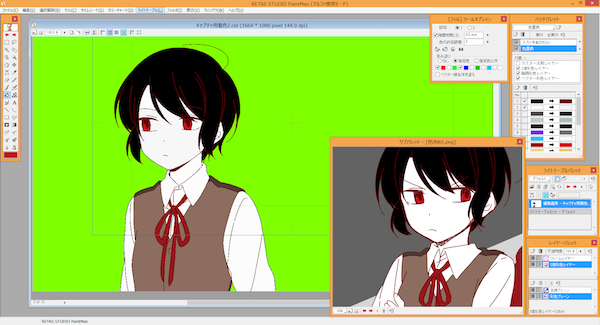わんにゃんぷーさん「うごイラ」メイキング&インタビュー! 妥協を許さない職人気質クリエイターのこだわりとは

文:小川 陽平
pixivコミックで好評連載中の『殺伐シェアライフ』。神さまの天罰を受けた吸血鬼のフジと口裂け男のサキグチがひとつ屋根の下で暮らすという、奇妙で殺伐とした共同生活=シェアライフの様子を描いた作品です。そしてこの度、『殺伐シェアライフ』のコミックス化が決定! 第1巻が、2016年7月27日(水)に発売されました。
作画を担当されているのは、漫画家・イラストレーター・アニメーション動画作家という3つの顔を持つ、わんにゃんぷーさん。キャラクターの機微を丁寧かつダイナミックに表現した手描きアニメーションは、多くの人の記憶に印象深く刻まれているのではないでしょうか。
そして今回、『殺伐シェアライフ』のコミックス発売を記念して、わんにゃんぷーさんがフジとサキグチの「うごイラ」を制作してくださいました! わんにゃんぷーさんが、彼らにどのように命を吹き込むのか、メイキングで迫ります。さらに、動画制作へのこだわりや『殺伐シェアライフ』の制作裏話についてもお伺いしました。
作画を担当されているのは、漫画家・イラストレーター・アニメーション動画作家という3つの顔を持つ、わんにゃんぷーさん。キャラクターの機微を丁寧かつダイナミックに表現した手描きアニメーションは、多くの人の記憶に印象深く刻まれているのではないでしょうか。
そして今回、『殺伐シェアライフ』のコミックス発売を記念して、わんにゃんぷーさんがフジとサキグチの「うごイラ」を制作してくださいました! わんにゃんぷーさんが、彼らにどのように命を吹き込むのか、メイキングで迫ります。さらに、動画制作へのこだわりや『殺伐シェアライフ』の制作裏話についてもお伺いしました。
フジとサキグチが動き出す! うごイラメイキング
それではさっそく、わんにゃんぷーさんが制作してくださった「うごイラ」のメイキングをお届けします。納得する動きになるまで何度でも描き直すという、職人気質なこだわりに注目です。
1. アイデアスケッチ

使用ソフト:CLIP STUDIO PAINT EX、Photoshop
まず動画全体の雰囲気を考えつつ、色を決めていきます。

ここで加工の仕方やフィルタの重ね方などを決めておくと、あとで着色や編集をするときに悩まないので、アイデアスケッチは必ず作るようにしています。
2. ラフ作業

使用ソフト:RETAS STUDIO Stylos
※ Stylos:RETAS STUDIOにパッケージされているデジタル作画ツール
※ Stylos:RETAS STUDIOにパッケージされているデジタル作画ツール
ここからはアニメーション制作ソフトのRETAS STUDIOで作業を進めていきます。ちなみに、SAIや他のツールを使う場合でも基本的な手順は変わらないそう。
作品の雰囲気と制作方針ができたら、さっそくラフを描いていきます! 細かいディテールは無視して構わないそうですが、動きはこの段階でほとんど決めてしまうんだとか。
作品の雰囲気と制作方針ができたら、さっそくラフを描いていきます! 細かいディテールは無視して構わないそうですが、動きはこの段階でほとんど決めてしまうんだとか。

動きを決めるので、ここが一番大切な作業です。個人的にとても頭を使います……。

最初は全部引きの絵だったのですが、それだとつまらないなと思い、後半はアップに。そして、カッコイイ動きを模索した結果、今回は着地動作にしてみました!
描くときは、実際に自分で着地をしながら、腕や足、体全体の動きを考えるというわんにゃんぷーさん。実際の動きより少し大げさな方が”アニメっぽい”ので、思い切りよく描くのがポイントだそうです。

フジくんは軽く小回りのきいた感じを、サキグチくんは重くゆったりした動きをイメージしてアニメーションを作りました。

動きがきまったら、ざくざく描いていきます。肩の上げ下げや首を回す動きが無理なく行えるかに注意。


「ため」と書かれたカットは、動きの終わりで余韻を表現するためのもの。ピタッと止まると不自然に見えるので、ひとつ前の動きを若干”ひきずった”動作になるようにするのがポイントです。動きの進行方向に合わせて、ほんの少しずらして描きます。

数字は、中割の箇所をしてしていて、「5×7」の場合は5枚目と7枚目の中割、「16×19」の場合は16枚目と19枚目の中割という意味です。「21より×〜」と書いてあるのは21枚目に寄せて中割をするという意味。つまり、後ヅメ・先ヅメ(※)のことです。
※ 後ヅメ・先ヅメ…基準となる原画に対する中割のタイミングを示すアニメ制作用語。後ヅメは「はじめは速く、徐々にゆっくりと」、先ヅメは「はじめはゆっくり、徐々に速く」という指示
3. 下描き

使用ソフト:RETAS STUDIO Stylos
次にラフを元に下描きをしていきます。最終的な動きの確認も兼ねているので、身体のラインはしっかりと描くとか。

この段階で動きが気に入らなければ、ラフからやり直したり、下描きを大きく変えたり……。とにかく自分が気に入る動きになるまで描き直し続けます!

裸の状態で納得いく動きになったら、上から服や髪の毛を描き足していきます。このとき、髪の毛やリボンタイ、フードの紐な重さが軽いものは大げさにふにゃふにゃ動かすようにすると、動きがより派手に見えるとか。


下描きをしながらなんとなく目は閉じない方がいいかも……と感じたので、目をあけることにしました。実は、ラフと動きを変えているところもあります。
ラフと下描きで変わっている部分を比べてみると、わんにゃんぷーさんのこだわりがわかって参考になりそうです!
4. 線画作業

使用ソフト:RETAS STUDIO Stylos
続いて線画作業。下描きをひたすらなぞっていきます。線が汚くなったり途切れたりしないよう、とにかく丁寧に。


線が重なるところは失敗すると怖いので、あらかじめ別のレイヤーで描いておきます。動かしてみてうまくいったら、不要な部分を消して、すべて黒い線に。ちなみに影を付ける場合は、この段階で付けます。

髪の毛と中割絵は曲線ツールを使って描くと楽に描けるそうです。
5. 着色作業

使用ソフト:RETAS STUDIO PaintMan
※PaintMan:RETAS STUDIOにパッケージされているアニメ特化型のペイントツール
※PaintMan:RETAS STUDIOにパッケージされているアニメ特化型のペイントツール
次にStylosからPaintManにソフトを切り替えて着色作業の開始です。ここでは、アイデアスケッチで決めておいた色を使います。
基本はバケツ(塗りつぶし)ツールでひたすらポチポチしていくだけ。RETAS STUDIO Paintmanは、塗る前に二値化に変換されるので塗るのがとても楽なんだとか。
基本はバケツ(塗りつぶし)ツールでひたすらポチポチしていくだけ。RETAS STUDIO Paintmanは、塗る前に二値化に変換されるので塗るのがとても楽なんだとか。


サブパレット(右側の小さい画面)からアイデアスケッチを開くとそのままスポイトとして色を吸いながら使えるのでとても便利です!


色を付けていくと、ここでまた「なんか違う……」と感じたり不自然な箇所に気づいたりするので、その都度直していきます。

使用ソフト:RETAS STUDIO CoreRETAS
再度ソフトを変えて作業です。今度はCoreRETASという編集・撮影ツールを使い、これまで作成した素材をひとつにまとめます。
用意していた背景とフジくん、サキグチくんを一緒に動かして最終チェック! 今回はセルを縦長に作ってあるので、飛び降りてくる2人を追うようにカメラを動かしていきます。
用意していた背景とフジくん、サキグチくんを一緒に動かして最終チェック! 今回はセルを縦長に作ってあるので、飛び降りてくる2人を追うようにカメラを動かしていきます。

ここで、2人の最終的な立ち位置を決めていきます。

お互いの動きが確認しやすいよう距離を少し離していたので、ここで調整します。
ここでぼかし加工をすることもあるそうです。
6. 完成!

これで「うごイラ」の完成です!

アニメ作りはかなり根気のいる作業だと思います。私も毎回頭を抱えながら動かしているので、あきらめずに挑戦していただけたらうれしいです。時間がかかる分、できたときのよろこびもとても大きいですよ!
見てくださってありがとうございます!
見てくださってありがとうございます!
